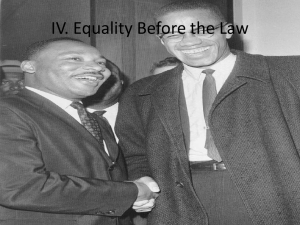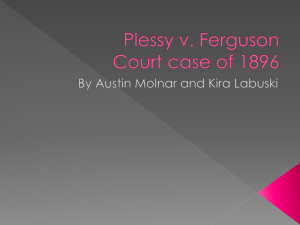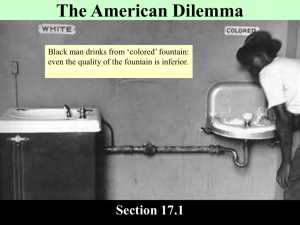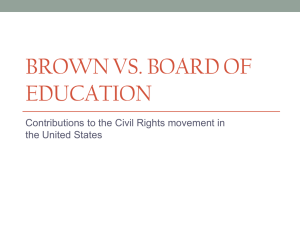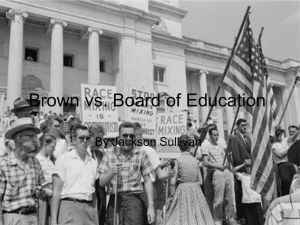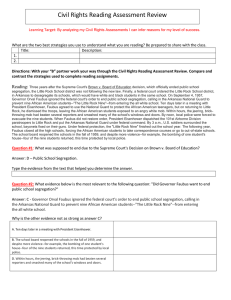How did the Civil Rights Movement campaign against segregation in
advertisement
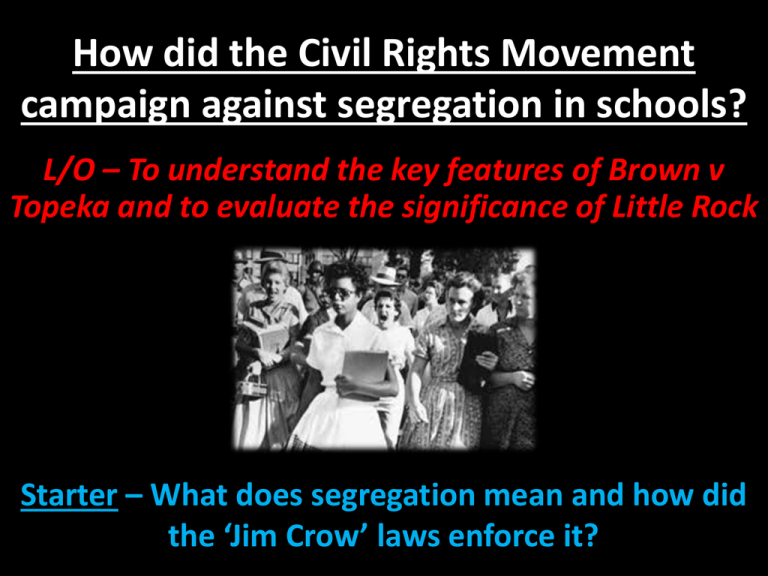
How did the Civil Rights Movement campaign against segregation in schools? L/O – To understand the key features of Brown v Topeka and to evaluate the significance of Little Rock Starter – What does segregation mean and how did the ‘Jim Crow’ laws enforce it? Plessy v. Ferguson 1896 • Despite the fact that Black People had equal rights under the constitution, states were legally entitled to pass their own laws. • This meant that states could pass laws that discriminated against black people without asking the central government for permission. These became known as the ‘Jim Crow’ laws. • In 1896, the Supreme Court ruled that individual states could impose segregation as long as the separate schools, hospitals and other services were ‘separate but equal’. Segregation WAS constitutional. 1. “The Plessy v. Ferguson case was a victory for black people as it ensures their equal rights in law” Do you agree? Explain your opinion… Brown v. Topeka 1951 • The Plessy v Ferguson ruling of 1896 that allowed ‘separate but equal’ facilities for black and white people meant black children in many states had to go to all-black school which were often poorly funded. Oliver Brown • In June 1951, Oliver Brown challenged this by going to court to try and integrate elementary schools in Topeka, Kansas. This was rejected. 2. Why do you think the Brown v. Topeka case was rejected by the State Judge? (Consider previous cases) Linda Brown Topeka, State Capital of Kansas Brown v. the Board of Education of Topeka 1954 • The NAACP (National Association for the advancement of coloured people) persuaded Brown to try again, this time at the Supreme Court. • The NAACP lawyers argued that separate education created ‘low self-esteem and was psychologically harmful as well as restricting education achievement for black students.’ • On 17th May 1954, the Supreme Court ruled that all public school segregation was unconstitutional. Brown had won and schools would now have to be integrated. 3. Why do you think the Judge agreed with Brown this time? Consequences of Brown v. the Board, 1954 Progress for Civil Rights? Set-back for Civil Rights? All school segregation was now deemed unconstitutional. Ruling did not give a date for integration. All public schools had to become integrated. Ruling left the speed of integration up to individual states, weakening the force of the law. Proved that Civil Rights could be achieved through legal, non-violent means. Most schools in Southern states ignored this ruling. Overturned the principle of Plessy v. Ferguson which meant other public services should in theory also be desegregated. Caused whites in the South to form White Citizens Councils to stop further integration and Ku Klux Klan began to re-emerge. Little Rock High School, 1957 • School integration was met with bitter resistance. Arkansas was one state that had done little to integrate its schools. • In 1957, the Supreme Court ordered the Govenor of Arkansas, Orval Faubus, to let 9 black students attend a white school in Little Rock. Little Rock High School, 1957 • Faubus ordered his state troops to prevent the black students from attending school. He claimed he could not ‘guarantee their safety’. • Faubus only back down when President Eisenhower sent federal troops to protect the students. They stayed for 6 weeks. Consequences of Little Rock High School, 1957 a) Read page 201 and use the information to fill in this grid: Progress for Civil Rights? Set-back for Civil Rights? b) Answer Questions 1-3 on page 200. Use your notes and pages 198-201 to complete your hand-out Event Brown v. the Board of Education of Topeka Montgomery Bus Boycott Little Rock Date What happened? What did the event achieve for Civil Rights? How significant was this event? (5=Very Important) Homework • Read pages 30-33 • Answer Questions 1, 2, 4, 7, 8 & 9 in books • Work is due next Monday 10th September
